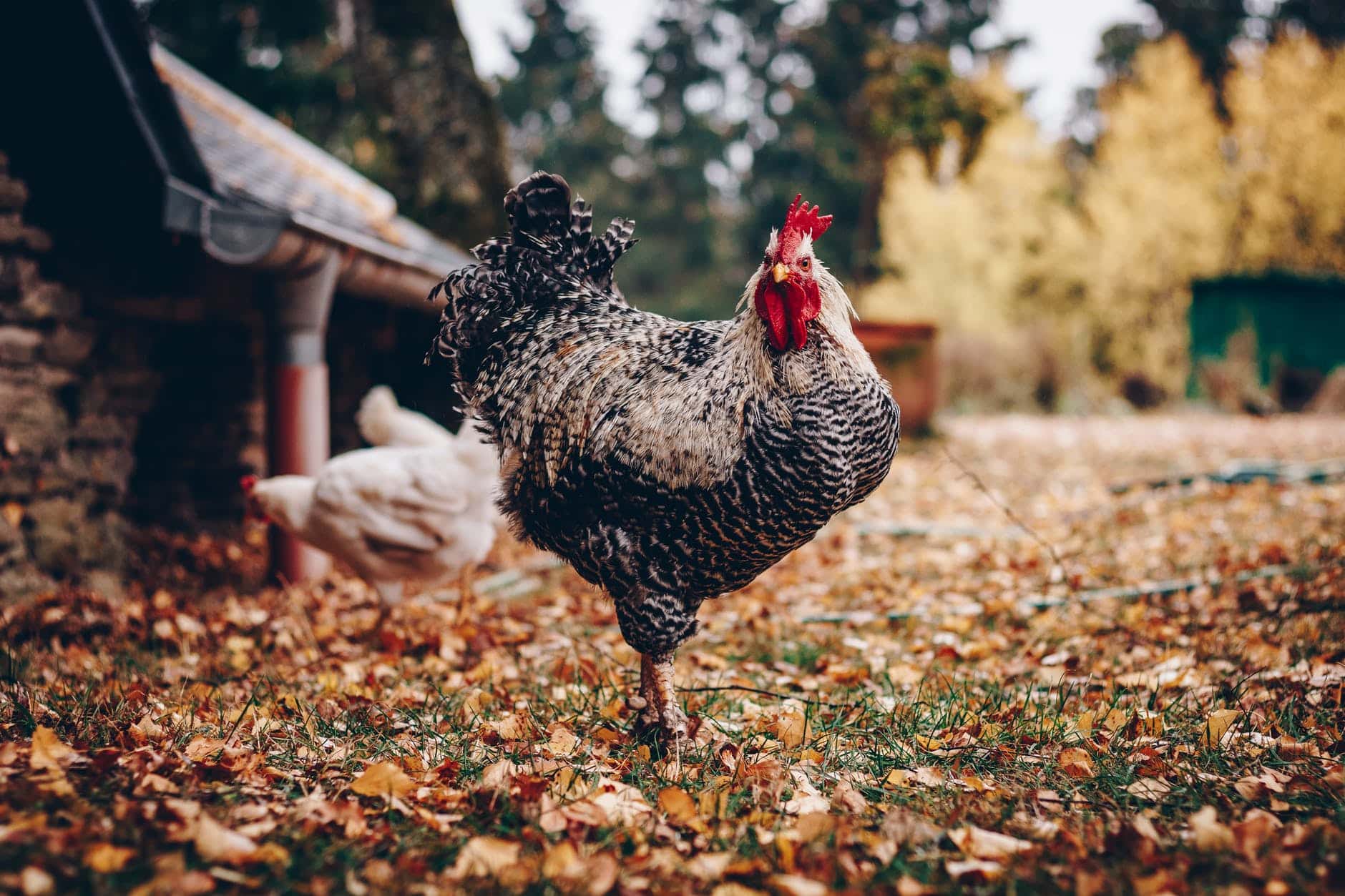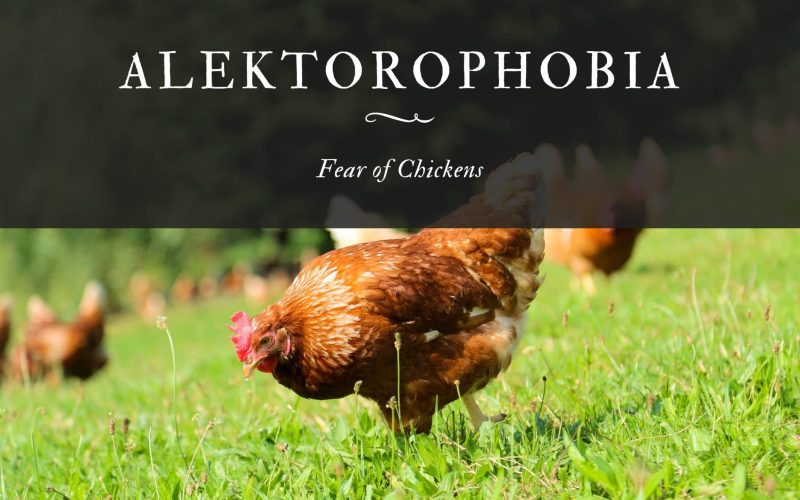Alektorophobia is a rare condition characterized by an intense fear of chickens. The word ‘Alektorophobia” was coined from two Greek words- “Alektor,” meaning “Rooster or chickens, and Phobos/ phobia, meaning fear.
Alektorophobia is often considered one of the numerous specific phobias that we have. As the name implies, a specific phobia is the fear of a particular place, object, or situation.
People with phobias often realize that their anxiety is entirely irrational; however, they seem paralyzed when confronted with the object of their fears.
Hence, we can say that alektorophobia is a type of anxiety that falls under specific phobias.
People who suffer from alektorophobia experience an uncontrollable and intense fear when confronted with chickens or hens.
In some, it can get so bad that just the mere thought of a chicken, the sight of chickens, or the picture of a chicken can cause them to begin to show symptoms of alektorophobia.
For some patients, their phobia can extend to even their choice of food and side dishes. Some alektorophobics can even find it very difficult to have chicken in their food plan.
Causes of Alektorophobia
Just like other phobias, the exact cause of alektorophobia is not known. However, according to the American Psychiatric Association (APA), most causes of phobias, including alektorophobia, can be attributed mainly to two distinct factors which include;
Genetics
Our genes are what basically make us up. The color of our hair, eyes, and skin, as well as everything else that makes up even the tiniest part of our body, is a result of the types of genes we carry.
Our genes are usually gotten from our parents and passed down from generation to generation.
In other words, for a person to develop any phobia, including alektorophobia, the person has to be genetically positioned or susceptible to it as a result of his/her family history.
This means that if a person has a family member (either distant or immediate) that has been seen to develop any form of mental or anxiety disorder, then the person has a higher chance of developing a mental or anxiety disorder.
However, it is essential to note that although a person may be genetically predisposed as a family member(s) has a record of anxiety and/or mental disorders, the person may not necessarily develop the exact condition as that of the family member.
For example, suppose a person’s immediate family member has a history of mental disorders such as schizophrenia or any anxiety disorder (e.g., selacophobia).
In that case, the patiemt may not develop either selachophobia or schizophrenia. Instead, the patient may end up developing other anxiety disorders, such as alektorophobia.
It is also important to note that although a patient may be genetically predisposed to developing alektorophobia, without adequate environmental conditions to act as a trigger, the person would not develop any symptoms associated with alektorophobia.
Environmental Factors
Most people who have a fear of alektorophobia don’t remember how or when their fears started.
All they know is that they went from being calm or super caring of chickens to being extremely afraid of them.
As earlier stated, once a person is genetically predisposed to developing alektorophobia, the patient still needs a trigger(in this case, environmental factors) to cause his/her generic predispositions to begin to manifest symptoms.
Generally, a particular part of our brain records and stores any occurrence we experience.
Any experience you have had, even as a young child till adulthood, is stored in a particular part of the brain known as the amygdala.
The amygdala not only records your experiences but also records all your reactions to those occurrences.
Hence, if a patient who has been previously predisposed to developing an anxiety disorder has a negative experience with chickens and hens, he or she would likely go on to develop alektorophobia.
Once the amygdala registers the patient’s negative experience with a chicken(which may have probably happened as a child), any time the patient sees a chicken, the amygdala begins to replay that experience.
Then, the patient starts to have an adverse reaction, hence developing an intense phobia of chicken(alektorophobia).
It is important to note that alektorophobia is not a very common phobia. People don’t just develop this phobia; it often occurs due to some bad experiences that may have happened with live birds or chickens.
According to research, people who have this fear live mainly on farms or have spent some time on or beside one.
Symptoms of Alektorophobia
As with other phobias, the symptoms of alektorophobia range from being physical to becoming psychological.
These symptoms also can be mild, severe, or incapacitating, as the case may be. The extent of the symptoms largely depends on their varying levels of fear.
Some of the physical symptoms can primarily be caused by the effects of adrenaline, which is released as a response to a situation of fight-or-flight.
Fear can induce a response of adrenaline rush in a person and, as such, lead to specific physical symptoms such as;
- Fainting, light-headedness, or dizziness.
- Increased heartbeats or palpitations
- Increased breathing rates.
- Nausea
- Vomiting
- Increased production of sweat
- Severe chest tightness that can lead to shortness of breath
- Severe chest pains
- Dry mouth
- Visible shaking(trembling)
The patient would likely experience some psychological symptoms, which can include;
– Visible avoidance of chickens. People who experience alektorophobia will do their best to avoid the sight of chickens.
Some would go to great lengths to avoid the sites of chickens, and as such, their fear can affect some of their major life decisions and daily lives.
– Some patients would begin to experience self-blame and guilt over their irrational fear of chickens.
Some patients tend to feel embarrassed that they have alektorophobia and, as such, may not want to seek help or even talk about it with outsiders.
– Some patients who are suffering from alektorophobia would avoid having anything to do with a farm.
The mention of a farm would throw such a patient into visible disarray and even cause them to exhibit physical symptoms.
Diagnosis of Alektorophobia

As it is often said, proper diagnosis is the first step to successful treatment. For alektorophobia to be properly diagnosed, the patient has to see a registered and well-trained psychologist.
Your psychologist would use the Diagnostic and Statistical Manual for Mental Disorders(DSM-5).
This manual will help your doctor diagnose appropriately if you are experiencing a phobia(alektorophobia), fear, or a simple anxiety disorder.
For alektorophobia, this manual states that the patient should experience immediate and intense fear when confronted with thoughts and pictures of chickens and hens.
- The patient should experience immediate and intense fear when confronted with thoughts and pictures of chickens and hens.
- Feelings of anxiety worsen when the patient is told that a chicken is about to be brought into the room or place where the patient is.
- The patient would physically try everything within his/her capacity to ensure that they avoid chickens at all costs.
- The patient would experience fear that is often exaggerated when an actual chicken is brought close.
- The patient experiences symptoms of alektorophobia that are severe enough to interrupt the person’s daily routine.
- The patient has been seen to have avoided chickens for at least 6months.
- The patient is seen to experience such intense levels of fear that can’t be linked to other conditions, such as Obsessive-Compulsive disorder (OCD) or post-traumatic stress Disorder(PTSD).
Treatment of Alektorophobia
Like other phobias, no defined medication or treatment can be used for the treatment of alektorophobia.
However, there are specific treatment methods that have been seen to help the patient relieve and, in some cases, deal with their fears. This treatment plan may include;
Talk Therapy
Talk therapy or Cognitive behavior therapy is a treatment plan that involves the patient having deep conversations with the psychologist.
As pointed out earlier, some people dealing with alektorophobia may not even know when their fear started. Hence, talk therapy helps the patient identify his/her fears and when and how they started.
It also involves the therapist helping the patient identify and replace their fearful thoughts with more rational ones.
Exposure Therapy (Desensitization Therapy)
As the name implies, this therapy involves exposing patients to their fears(chickens) in a controlled environment.
The primary goal of this is to desensitize the patient from his/her fear and make the patient see that their fear is irrational.
Exposure therapy often works alongside talk therapy, and according to APA, it is the leading treatment option that is often used for specific phobias.
After cognitive behavioral therapy desensitizes the patient from their fears, the patient is gradually exposed to the idea of chickens.
The patient may be given a picture of a chicken or videos of the chicken. After the patient has successfully familiarized himself/herself with the idea of chickens, One may eventually bring a chicken into the room.
The Use of Medications
Often, The therapist may give drugs to the patient depending on the severity of their physical symptoms.
However, it is essential to note that these medications don’t treat the phobia itself; rather, they help relieve the patient of his/her physical symptoms and prolong the patient’s quality of life.
Also, medications can be introduced if the patient experiences difficulty in one of the therapy sessions, especially the exposure therapy session.
Some of the medications used include;
Antidepressants and Antianxiety Drugs
These drugs include benzodiazepines such as Valium and Xanax.
The primary role of these drugs is to prevent the patient from developing panic attacks and also to reduce the level of anxiety the patient is experiencing.
Beta-blockers
The main need for this type of medication is to prevent the surge of adrenaline rush as well as its effects when the patient experiences alektorophobia.
When prescribed by the therapist or the family doctor, a combination of these drugs can help relieve the patient’s physical symptoms.
However, one must be careful when prescribing these drugs to prevent drug addiction.
Hypnotherapy or Hypnoanalysis
Hypnotherapy has been proven to be a helpful tool in helping the patient identify the source of their fears.
Hypnotherapy also helps patients develop new ways and ideas to help them deal with their fears.
In 1958, the American Medical Association approved this type of treatment, and it has been used to treat many phobias since then.
Neuro-linguistic Programming
Neuro-linguistic programming is another proven useful method used for treating alektorophobia.
This type of science is based on the principle that most individuals dealing with phobias will likely coin words that are related to his/her phobia.
Once the word(s) have been coined, the person will continue to use and rethink them every time, causing fear in the first place.
Therapists who practice this method study the patients’ facial expressions and eventually help them remodel their thoughts when they are faced with the object of their fears.








